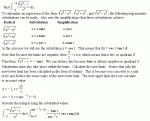You are using an out of date browser. It may not display this or other websites correctly.
You should upgrade or use an alternative browser.
You should upgrade or use an alternative browser.
integrals with roots
- Thread starter CalcGuy
- Start date
tutor_joel
Junior Member
- Joined
- Feb 6, 2010
- Messages
- 157
It's pretty straight forward. You can see where the inverse sec (-9) comes from right? since it's simply a straight substitution. the 2pi/3 however comes from the unit circle. So, if
-2 = sec(t), then cos(t) = -1/2 right? Which is in the second quad of the unit circle, and what is the value of the angle? 120 degrees or 2pi/3
Make sense?
-2 = sec(t), then cos(t) = -1/2 right? Which is in the second quad of the unit circle, and what is the value of the angle? 120 degrees or 2pi/3
Make sense?
tutor_joel
Junior Member
- Joined
- Feb 6, 2010
- Messages
- 157
Thanks for the feedback, glad I could help
BigGlenntheHeavy
Senior Member
- Joined
- Mar 8, 2009
- Messages
- 1,577
\(\displaystyle \int_{-2}^{-9}\frac{\sqrt{x^{2}-1}}{x^{3}}dx \ = \ .367424, \ (trusty \ TI-89)\)
\(\displaystyle Let \ x \ = \ sec(t), \ \implies \ dx \ = \ sec(t)tan(t)dt\)
\(\displaystyle Hence, \ \int_{2\pi/3}^{arcsin(1/9)+\pi/2}\frac{[\sqrt{sec^{2}(t)-1}]sec(t)tan(t)}{sec^{3}(t)}dt\)
\(\displaystyle = \ \int_{2\pi/3}^{arcsin(1/9)+\pi/2}\frac{[\sqrt{tan^{2}(t)]}sec(t)tan(t)}{sec^{3}(t)}dt\)
\(\displaystyle = \ \int_{2\pi/3}^{arcsin(1/9)+\pi/2}\frac{|tan(t)|tan(t)}{sec^{2}(t)}dt, \ |tan(t)| \ = \ -tan(t), \ 2nd \ quadrant\)
\(\displaystyle = \ -\int_{2\pi/3}^{arcsin(1/9)+\pi/2}sin^{2}(t)dt \ = \ -1/2\int_{2\pi/3}^{arcsin(1/9)+\pi/2}(1-cos(2t))dt\)
\(\displaystyle = \ -1/2\bigg[t-\frac{sin(2t)}{2}\bigg]_{2\pi/3}^{arcsin(1/9)+\pi/2} \ = \ -1/2[t-sin(t)cos(t)]_{2\pi/3}^{arcsin(1/9)+\pi/2}\)
\(\displaystyle = \ -1/2[arcsin(1/9)+\pi/2-(4\sqrt5/9)(-1/9)-(2\pi/3-(\sqrt3/2)(-1/2))] \ = \ .367424 \ QED\)
\(\displaystyle Let \ x \ = \ sec(t), \ \implies \ dx \ = \ sec(t)tan(t)dt\)
\(\displaystyle Hence, \ \int_{2\pi/3}^{arcsin(1/9)+\pi/2}\frac{[\sqrt{sec^{2}(t)-1}]sec(t)tan(t)}{sec^{3}(t)}dt\)
\(\displaystyle = \ \int_{2\pi/3}^{arcsin(1/9)+\pi/2}\frac{[\sqrt{tan^{2}(t)]}sec(t)tan(t)}{sec^{3}(t)}dt\)
\(\displaystyle = \ \int_{2\pi/3}^{arcsin(1/9)+\pi/2}\frac{|tan(t)|tan(t)}{sec^{2}(t)}dt, \ |tan(t)| \ = \ -tan(t), \ 2nd \ quadrant\)
\(\displaystyle = \ -\int_{2\pi/3}^{arcsin(1/9)+\pi/2}sin^{2}(t)dt \ = \ -1/2\int_{2\pi/3}^{arcsin(1/9)+\pi/2}(1-cos(2t))dt\)
\(\displaystyle = \ -1/2\bigg[t-\frac{sin(2t)}{2}\bigg]_{2\pi/3}^{arcsin(1/9)+\pi/2} \ = \ -1/2[t-sin(t)cos(t)]_{2\pi/3}^{arcsin(1/9)+\pi/2}\)
\(\displaystyle = \ -1/2[arcsin(1/9)+\pi/2-(4\sqrt5/9)(-1/9)-(2\pi/3-(\sqrt3/2)(-1/2))] \ = \ .367424 \ QED\)

